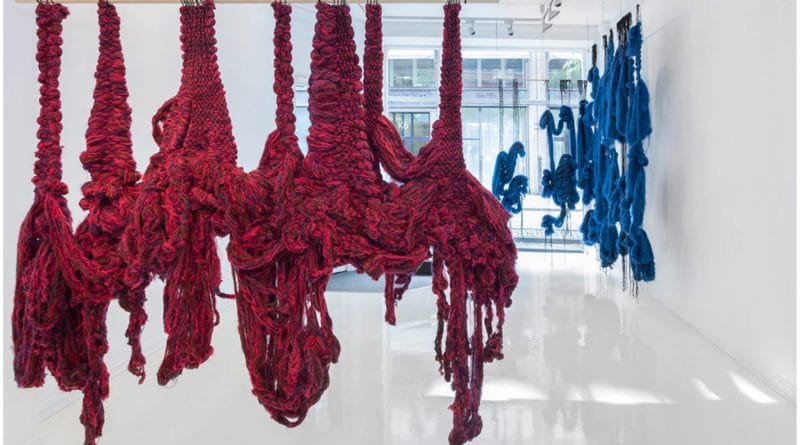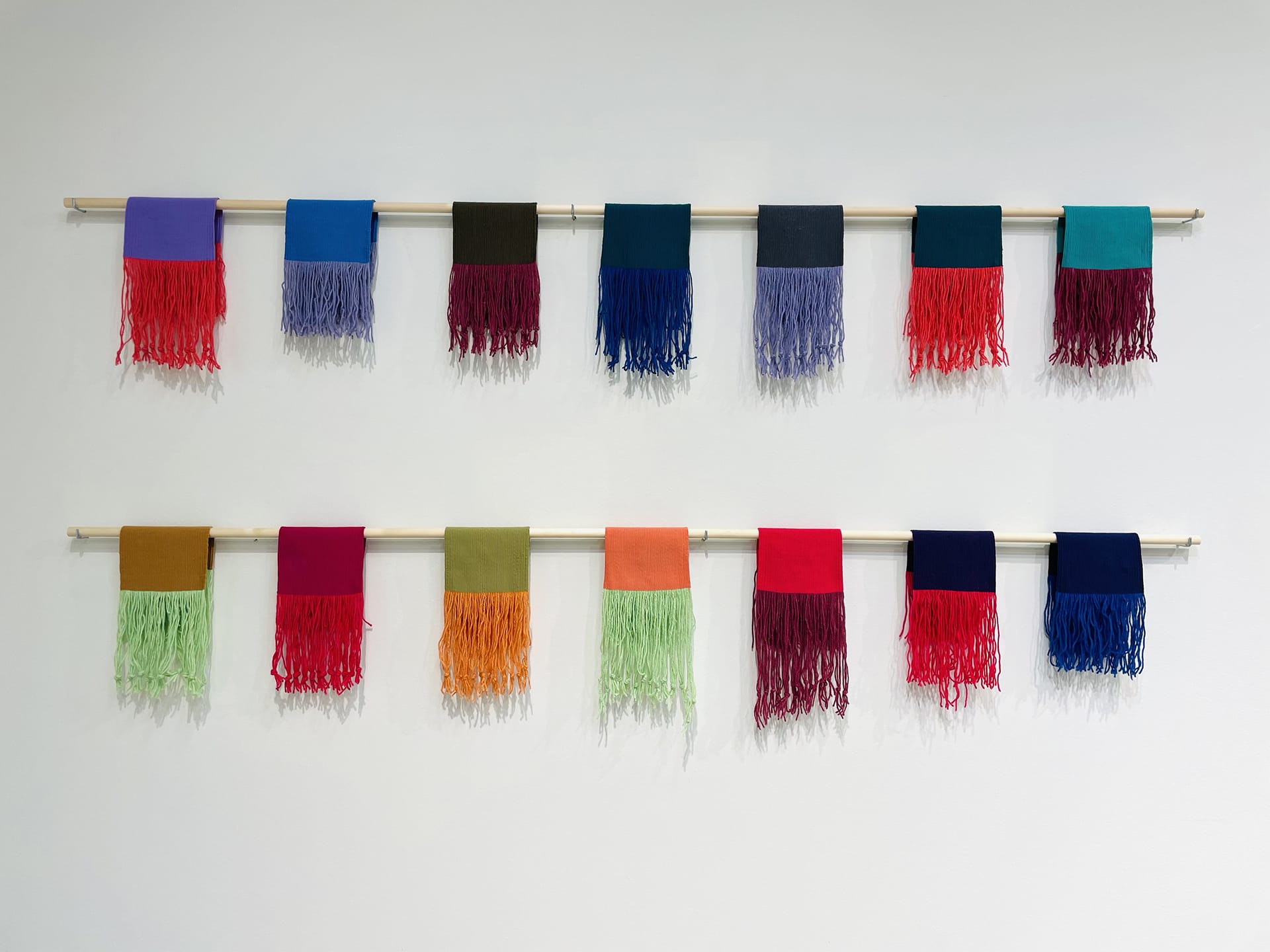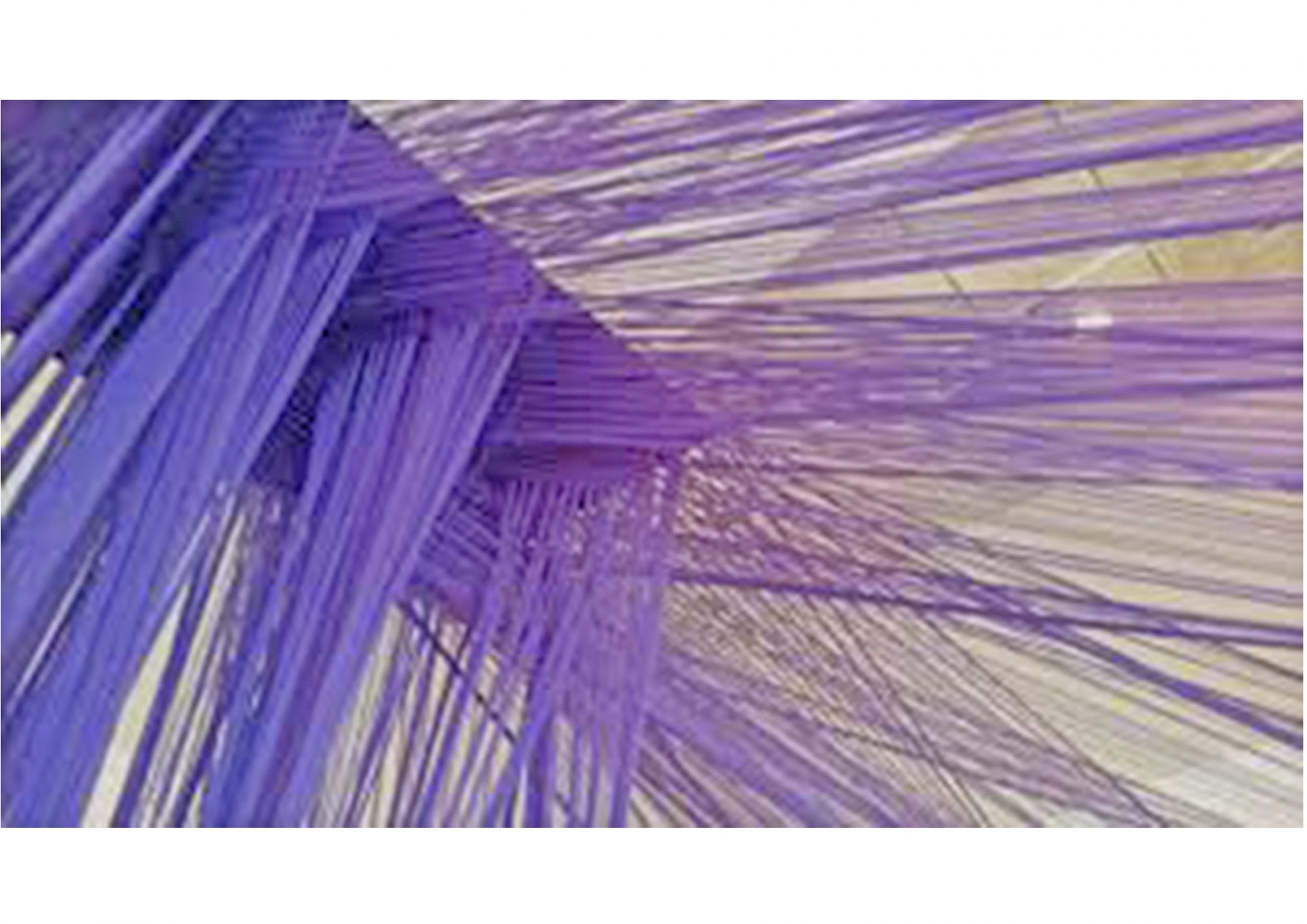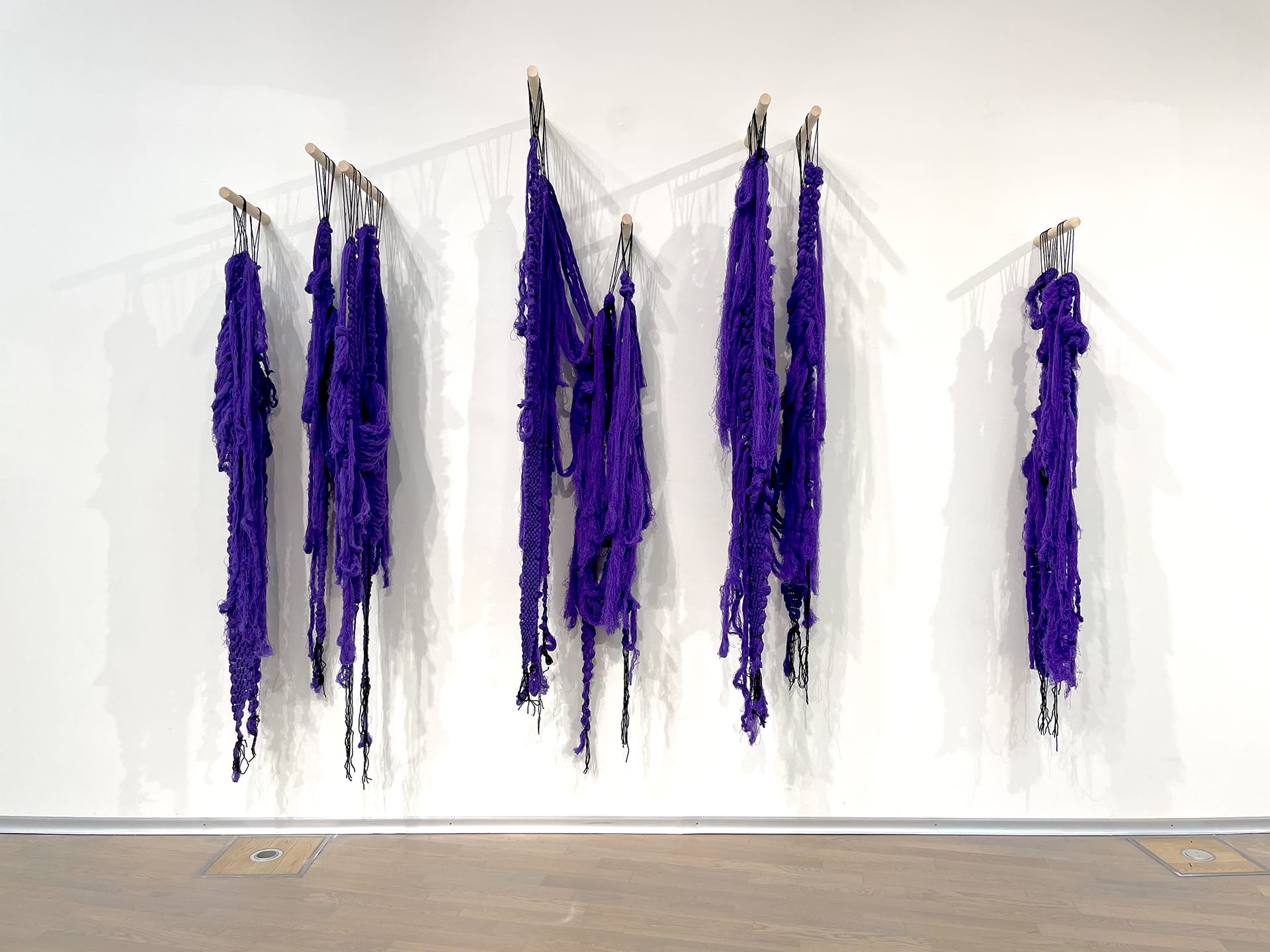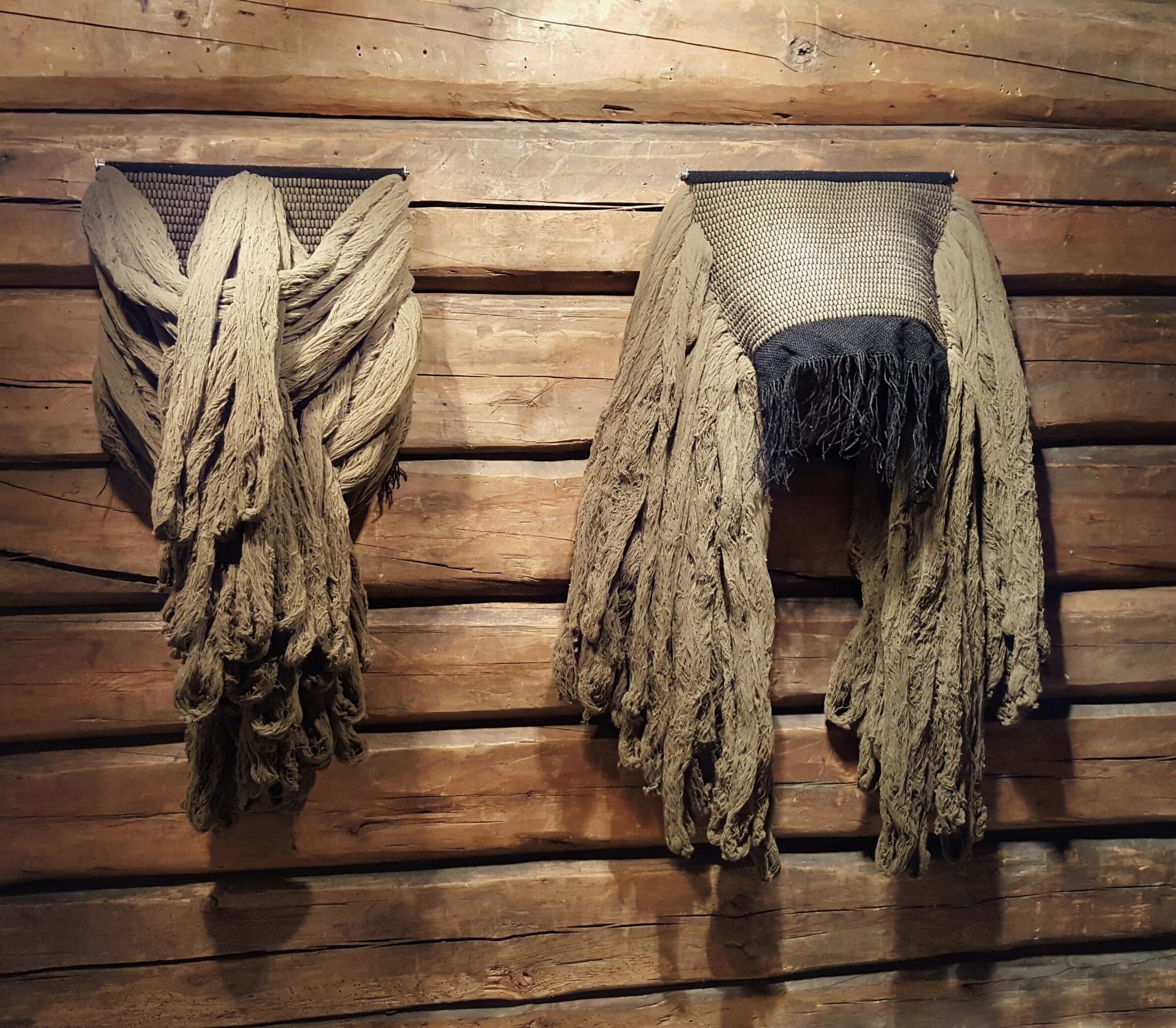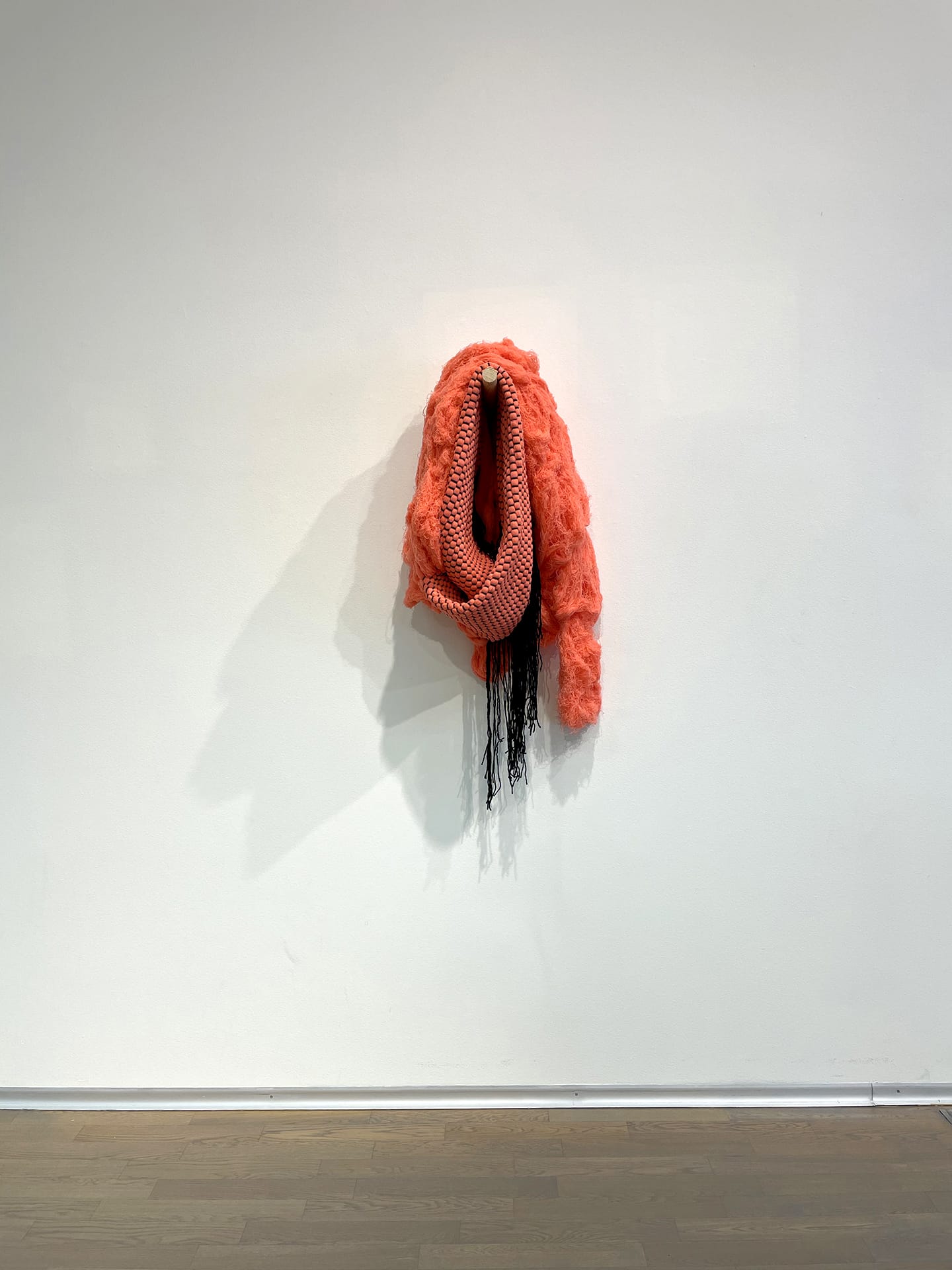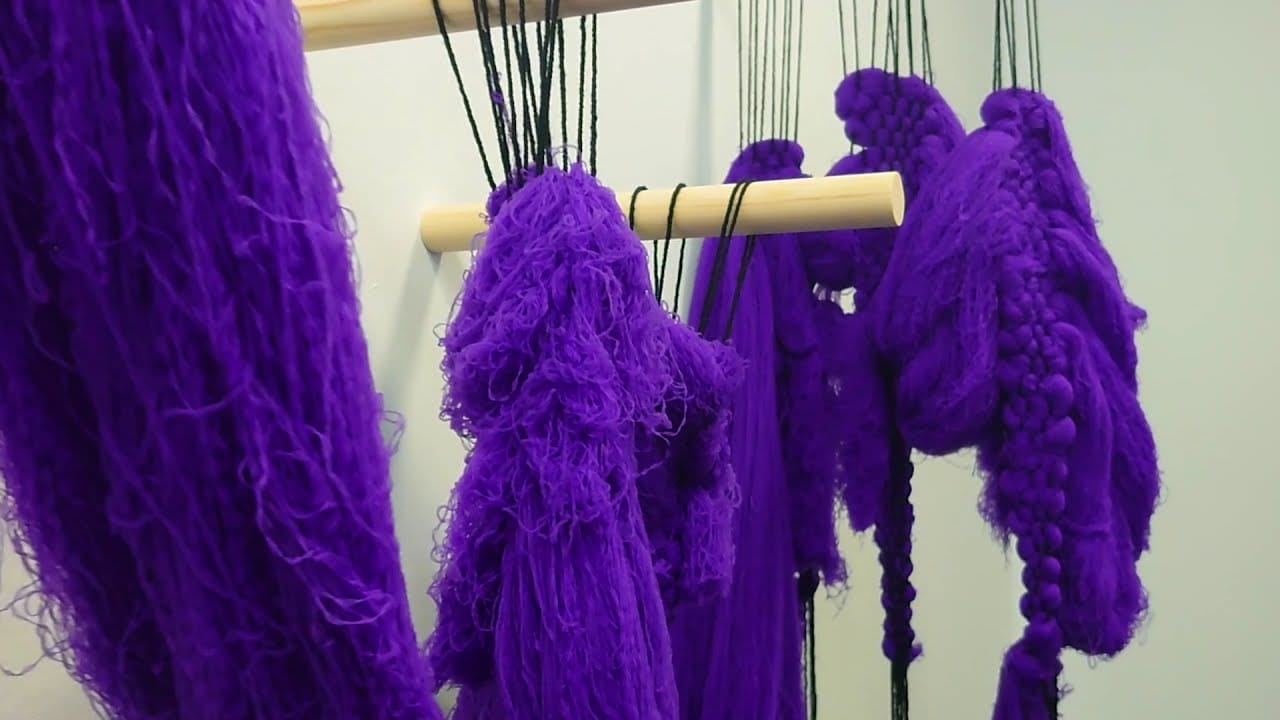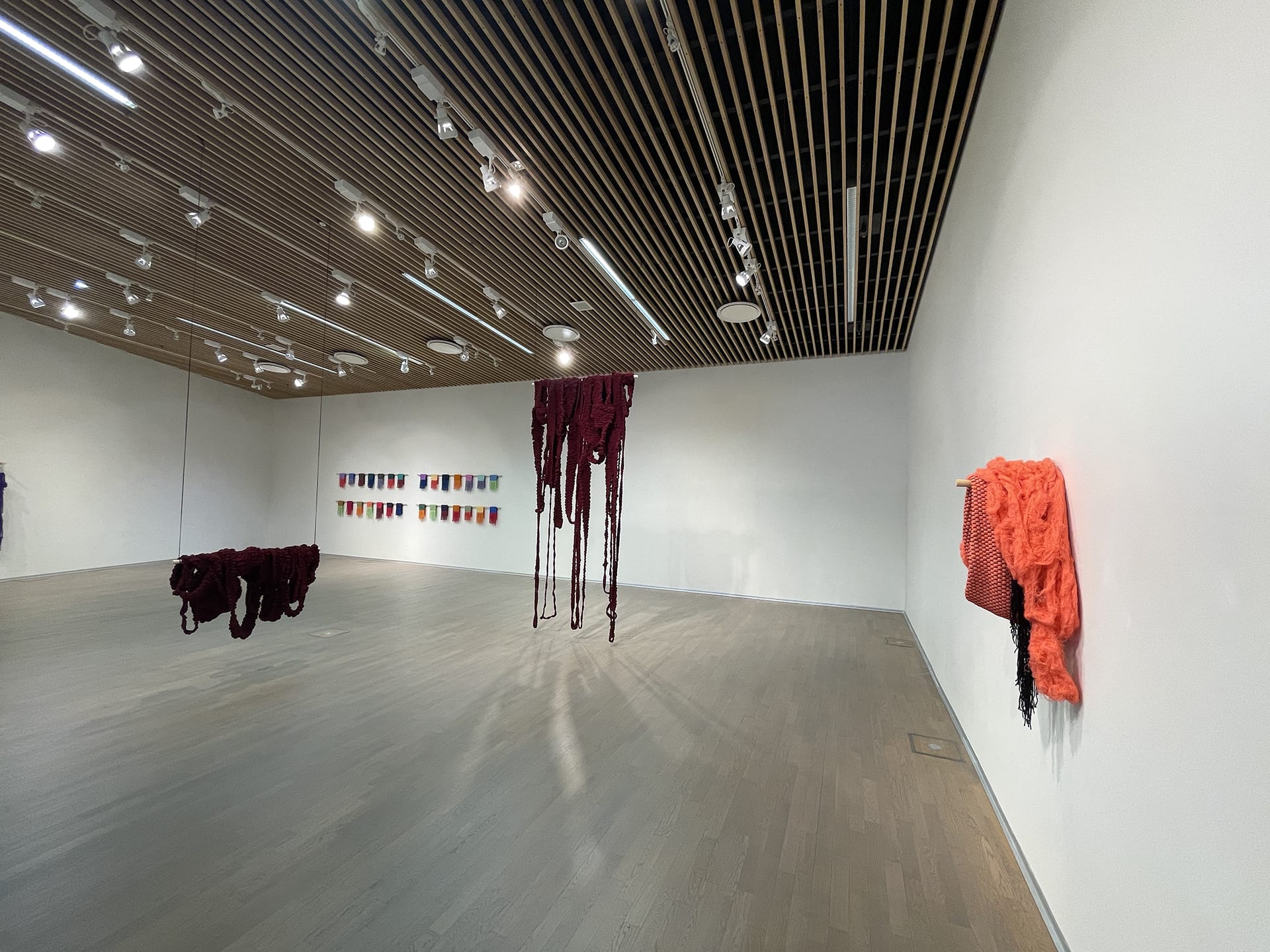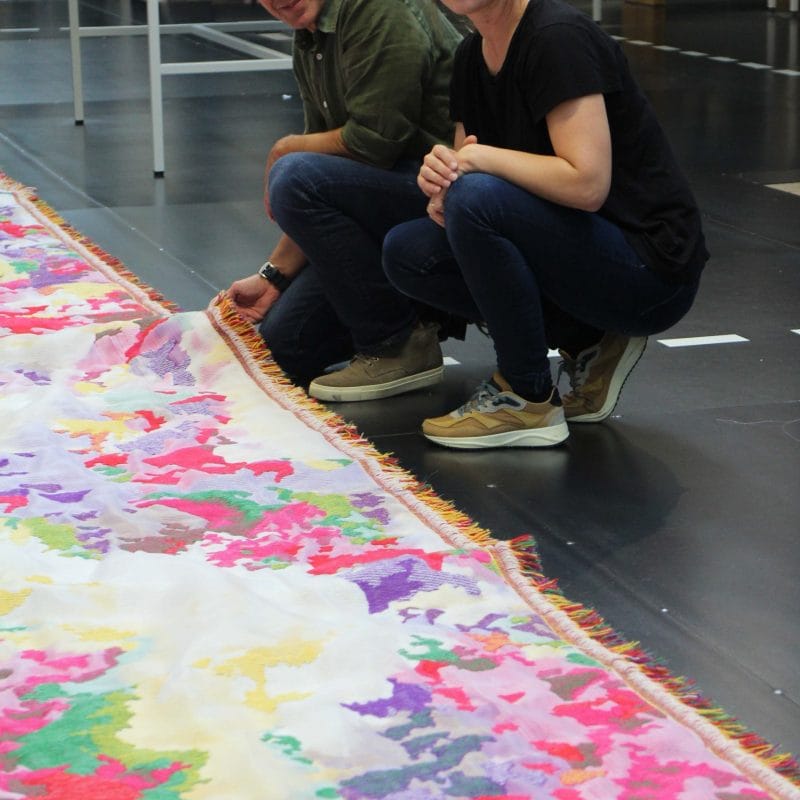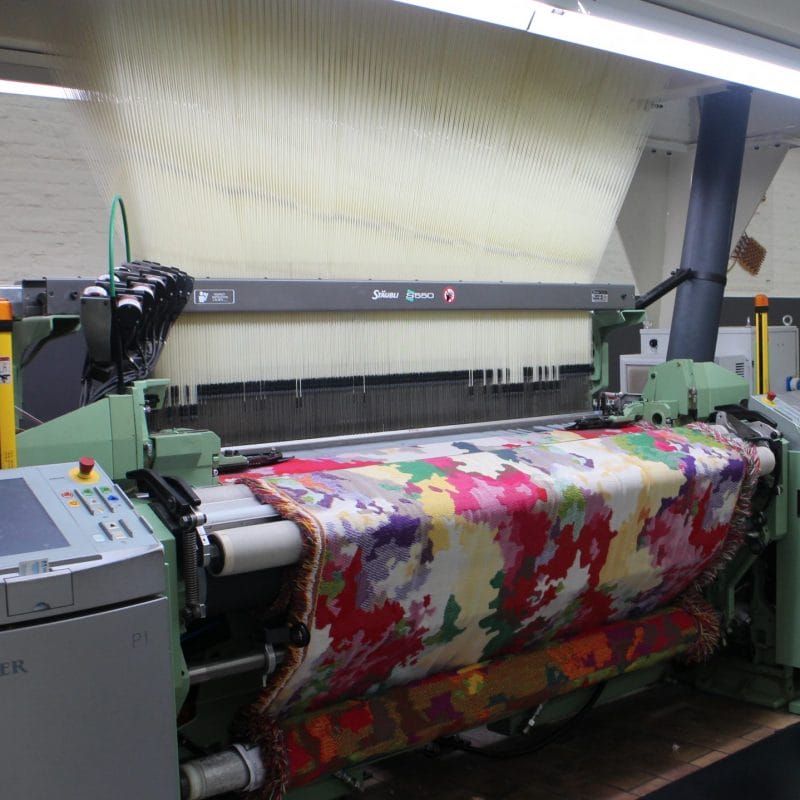ELIN IGLAND
*Feautered photo: From the exhibithion «Weights and Free Flocs of Birds» at Soft Gallery in 2017. Photo Credit: Øystein Thorvaldsen
Elin Igland, 1982, is a Norwegian textile artist, living in Landvik, Grimstad.
Igland holds a bachelor’s degree in textile art from the Bergen School of Art and Design (2006-2009) and a master’s degree from the Oslo School of Art (2010-2013).
Her practice reworks the textile tradition; the classical structures of warp and weft are, for Igland, a constant subject of inquiry and a basis on which to experiment with materials, techniques and concepts. As a result, her work reflects a broad awareness of this expressive medium.
Her historical and technical knowledge, based upon years of academic study and apprenticeship in Como, Italy, in 2009, where she worked as a textile designer and intern, and in Tilburg, the Netherlands, is complemented by the experimental knowledge of modern Norwegian textile art.
For the last 10 years, Igland has participated in several major exhibitions, including Southern Norway Art Museum in Kristiansand, Gallery 3,14 in Bergen, Trafo Art Gallery in Asker. Her first solo show was hosted by Kampen Visningsrom in January 2014. In October of the same year, Igland opened a large solo exhibition in Reimangården with the support of the Grimstad Art Association. Her latest solo exhibition took place at Soft Galleri in Oslo (2017) and Buen Gallery in Mandal (2022).
The artist’s practice has been supported by major awards: regional and state grants such as Statens kunstnerstipend and support from Bildende Kunstneres Hjelpefond (BKH).
In this interview, the Norwegian artist explains the process and thinking behind her works and how her interesting visual language has developed.

Woven installation «spring freely» at Reimangården in Grimstad, woven by hand on a digital TC1-loom. Credit: Elin Igland Your practice involves a material-based approach that experiments with and reinterprets traditional weaving techniques. Can you explain your relationship with tradition and the liberating aspect of this creative action?
In set traditions, there are often several roles and expectations to relate to – I would rather be without these frameworks, and construct my own expressions based on my own thoughts, values, materials, and techniques. Many traditions benefit from being discussed and broken.
I draw a lot of inspiration from the moments in textile art, and especially history, where traditions were challenged and broken, which have opened other possibilities for interpretation and expression in textiles. In the Norwegian textile art community, we have a unique history and long experience of experimenting with textile expressions in visual art, with a liberation from the traditional. This has roots back to i.a. The artist action in 1974 and the formation of the association Norwegian Textile Artists. My colleagues and I have many before us we can thank for this freedom. The freedom I can work with as an artist it is not obvious and must be safeguarded constantly.
In my practice, I alternate between working freely and using the technical system in the loom, such as Patterns, the grid and combinations of warp and weft. The properties of the material are important. I experiment and investigate to what extent I can be independent of the loom as a machine, and ask questions like when is this no longer weave? What defines a tapestry? And what defines the flat, two-dimensional vs. the sculptural, spatial, and three-dimensional?
In 2009, you lived in Italy, working as a trainee textile designer. Can you tell us about the formative experiences that contributed to the development of your practice?
This was a very exciting experience and has given me a lot of inspiration! I got to experience the textile industry from a different point of view than what I know. It gave me a lot of knowledge and an insight into the Italian textile industry and its culture, which was fantastic. It was instructive to experience how textiles for the European fashion houses were worked out and produced. There is an enormous amount of knowledge and creativity that was fantastic to learn from. The industry is sometimes both close and far away from how I work in my practice, but I still see parallels with the experimental, how the material has its function and how you can work technically in the loom to be able to bring out the visual expressions you want.
I work very materially, and in process and constantly get new ideas by working with technique and material, and in that way materialize an object, a sculpture, or an installation. By working with material and being hands-on, the conceptual and the thoughts behind the work I do also come. In Como and the textile industry, one is hands-on in a different way; you look at patterns, samples, qualities, colours, combinations and work towards a visual expression. Como was a wonderful place. I am incredibly impressed with their knowledge and dedication to the textiles and the industry.

Detail of the woven installation «spring freely», woven by hand on a digital TC1-loom. Ph. Credit Elin Igland Most of your sculptures are abstract – with very organic surfaces mixed and juxtaposed with others regulated by the geometric intersection of warp and weft. How and why did you choose to alternate these aspects?
I alternate between weaving on industrial jacquard machines, hand-weaving and weaving freely in the room by hanging up the warp on hooks in the ceiling and walking around with wefts, where I almost act as a giant shuttle. This ranges from very intricate industrial machines that require precision, to being able to work as big and rough as possible by deciding everything even, in what I call free loom. This is a need and a contrast I alternate between working in. The contrast I an inspiration to me, and what occurs when the material is allowed to behave without having to conform to the looms system and grid. This is the excitement I often work in; what occurs when the looms principles, as the grid and technology, that provides the system and the ability to hold thousands of threads in place, disappear? The nature of the material is to curl itself. What happens without mechanical and human influence and control, and the tight grid? When is it no longer a tapestry? What defines a tapestry?

«Grid Extensions – purple bodies» From the solo exhibithion Grid Extensions at Buen Gallery in Mandal, 2022. Norwegian wool, synthetic yarns and wood; how do you choose the materials for your works?
Material contrasts are important to me, and the concept around materials; what do they mean? What qualities do they have? Where are they from? On what intention are they made? The wool I use comes from a fantastic spinning mill named Norsk Kunstvevgarn, which stays nearby my hometown in Norway. Norsk Kunstvevgarn and the Hoelfeldt-Lund family spins yarn from Norwegian Spæl-sheep, specialising in tapestry. They have produced yarn for decades, with extraordinary quality and hand-picked fibres with qualities such as gloss and strength, so that the yarn will provide quality, especially for tapestries. H. Lund has also made a special warp in wool from Spæl-sheep – a quality with lots of strength and stiffness where the warp-thread have fibres that protrude and act as hooks against the light nylon quality.
The nylon is a quality used in the knitwear industry and has an effect where it expands when it comes from its cones. This is a property I have used in weaving to get volume between layers and as a volumizing effect in the weaving surface when I use industrial looms. Eventually, I started experimenting with this nylon quality in my free-loom experiments and bundled the thread into thicker bundles that I could use as a weft when I weave freely in the room.
The combination of this rigid wool fibre and the fine nylon quality makes the yarns stick together and interact with each other. It provides an opportunity to work with the sculptural form and the visual expression I want.

"Tigerhomage» 2021. From the solo exhibition Grid extensions vol 2 at Buen Gallery, Mandal. This piece is a homage to the former artists, a group of strong women, who founded The Norwegian Association of Textile Artists. They fought for their freedom to work as artists, to use textile as a medium in art, and they called themselves tigers. Ph. Credit Elin Igland The thread seems to play an essential role, becoming a protagonist on a formal level and suggesting hidden meanings (as in work Lodd og Frie Fugleflokker); what significance does it take in your practice?
The thread and the material play a very important role. With an abstract expression, it is the materials, shape and colors that stand in the front line and meet the viewer. These hidden meanings are present in different degrees, some distinct others completely abstract. The titles I use play an important role as part of sending viewers into a meaning. At the same time, I want to have as open an interpretation space as possible for the viewer; I want them to be responsible for the experience of the works themselves; either as colour and materials together with the architecture and space, nothing more. Or as more symbolic interpretations they find in the experience of an abstract work of art.

From the solo exhibition «Grid Extensions vol 2 » at Agder Art Gallery in Kristiansand, 2021. Photo credit: Christina Leithe Hansen In addition to a visual force of their own, your works dialogue with each other and space. Can you expand on this relationship?
In my process, I always work with the room where my next exhibition is set, in mind. The combination of the different objects is essential, and I want them to work together in the gallery space and give the audience a holistic and spatial experience. How the different objects are mounted, how many objects are in the room, what height they hang on the wall, how the sculptural objects hang in the room in relation to the objects mounted on the wall is very important to me when I mount an exhibition and affects the experience of all objects together in the room, and the experience of each single object.

From the exhibithion «Weights and Free Flocs of Birds» at Soft Gallery in 2017. Photo: Øystein Thorvaldsen In Ny Horisont, created for the Nye Flekkerøy Kirke altar, a typical Scandinavian sky of light and clouds stands out against the wall’s concrete background. The thread is present, but the textile technique used here seems different from your other works; how did you create this work and what inspired you
This altar installation is manufactured at Textile-Lab in Tilburg, the Netherlands. An amazing place I stayed as a trainee before I went to Como. In this lab, you have the opportunity as an artist to produce works on industrial weaving machines. A completely unique place, where you can use the machine in a different way than otherwise. You can experiment and push the machines largely to produce the expression you want, regardless of having to stick to what else you must do when working on the same machine in the purpose of weaving meters of textiles; pace of weaving, stable materials for the loom to work without complications, the pattern must be balanced so that the warp works for many meters, etc. The desire for this work was to be able to use the high-quality materials that H.Lund produces for tapestries, in industrial machines, because they have a completely unique quality that such a church project deserves.
As far as I know, this has not been used like this in any other projects, because the thread is so stiff, and way too thick for that purpose. But luckily, we made it possible at the Lab, with lots of testing and finding solutions for it to work with the looms. I also wanted to use these materials form H.Lund, which have a long tradition to be used in church textiles. The church previously had an altar tapestry woven by the Norwegian weaver Else Marie Jackobsen, which is a great inspiration. The inspiration for this work was also an anchorage for the religion and the people who use the church. Flekkerøy is a beautiful place with a long tradition associated with nature, sea, and fishing. The visual starting point is from a tiny stone that lay on the old church steps. It was magnified in a microscope, and the most amazing colours emerged; the same colours that are central to the Christian faith; the liturgical colours green, red, purple, and white. The architecture was also a basic aspect in the proses with this project.
2022 seems to be an eventful year for you; what are your plans?
My plans for 2022 and further is to develop new sculptures and installations, both for group-exhibitions and solo. And some works towards public commissions.
In recent years, I have also worked with politics and organization in Norwegian Textile Artists – who run Gallery Soft in Oslo, a gallery based on textile art. This organisation and the women who started it back in the 70-ties are a huge inspiration to me. The freedom they fought for is not obvious, and has made a big impact on the possibilities myself and other textile artist work today – such freely and experimental. I am also attending the Textile Art Triennale – Textile Art of Today which is ongoing in eastern Europe throughout 2022.
